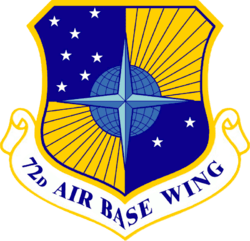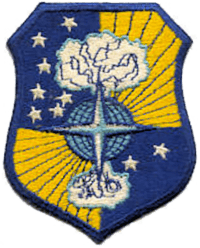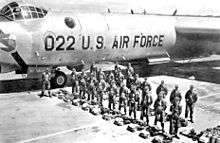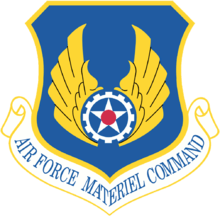72d Air Base Wing
| 72d Air Base Wing | |
|---|---|
 Official emblem | |
| Active |
21 August 1941–1 November 1943 13 May 1947–27 June 1949 16 June 1952–30 June 1971 1 October 1994– |
| Country | United States |
| Branch | Air Force |
| Part of |
Air Force Material Command Oklahoma City Air Logistics Center |
| Garrison/HQ | Tinker Air Force Base |
| Equipment | see "Aerospace vehicles" section below |
| Decorations | see "Lineage and honors" section below |
| Commanders | |
| Current commander | Colonel Christopher Azzano |
| Notable commanders | Lucius D. Clay, Jr. |

The 72d Air Base Wing (72 ABW) is a United States Air Force unit assigned to the Air Force Materiel Command Oklahoma City Air Logistics Center (OC-ALC). It is stationed at Tinker Air Force Base, Oklahoma. The wing is also the host unit at Tinker.
The diverse, multi-unit, multi-mission wing includes base services and support for the OC-ALC and associate organizations as well as dependents and retirees.
Established in 1941, the 72d is a successor unit to the World War II 72d Reconnaissance Group (Special) combat organization that had earned Antisubmarine and American Theater campaign streamers. The 72d Bombardment Wing, Heavy was a component wing of Strategic Air Command's heavy bomber deterrent force throughout the Cold War. The wing earned two Air Force Outstanding Unit Awards, flying RB-36, B-52 and KC-135 aircraft, before its inactivation on 30 June 1971 in Puerto Rico.
Its Command Chief Master Sergeant is Chief Master Sergeant Eric A. Harmon.
History

Activated in June 1952 as a Strategic Air Command very long range reconnaissance unit at Ramey AFB, Puerto Rico, but not operational until it absorbed residual resources of 55th Strategic Reconnaissance Wing in October 1952 when the 55th was reassigned to the newly activated Forbes AFB, Kansas administratively. Redesignated as 72d Strategic Reconnaissance Wing and received 3 (60th, 73rd and 301st) squadrons of RB-36D/E/F/H Peacemaker bombers. Conducted global strategic reconnaissance 1953–1955, gradually shifting to a bombardment training mission beginning in 1954, being upgraded to B-36J and B-36J(III) Featherweights by 1955. Redesignated 72d Bombardment Wing and received a squadron of KC-135A tankers in 1958.
With the phaseout of the B-36s in 1958, received B-52G Stratofortess intercontinental strategic bombers. It stood nuclear alert between 1959–1971 with the B-52G, was equipped with the AGM-28 Hound Dog cruise missile. Inactivated in 1971 due to a reduction of the number of B-52 wings, as part of a reduction/redirection of funding for combat operations in Vietnam and as ICBM wings took over an increased share of the nuclear alert duty. The wing earned two Air Force Outstanding Unit Awards, flying RB–36 [1952–1958], KC–135 [1958–1971] and B–52 [1959–1971] aircraft, before its inactivation.
In 1972, SAC activated the 72d Strategic Wing, Provisional at Andersen AFB, Guam. Although assigned the same number, this wing is unrelated to the 72d Air Base Wing.
The wing was reactivated as a base host wing under Air Force Materiel Command in 1994.[1] It provides services and support for the Oklahoma City Air Logistics Complex and other organizations at Tinker Air Force Base, Oklahoma.
Lineage
72d Reconnaissance Group
- Constituted as the 72d Observation Group on 21 August 1941
- Activated on 26 September 1941
- Redesignated 72d Reconnaissance Group (Special) on 25 June 1943
- Disbanded on 1 November 1943
- Reconstituted as the 72d Reconnaissance Group on 13 May 1947
- Activated in the reserve on 12 June 1947
- Inactivated on 27 June 1949[2]
- Consolidated with the 72d Bombardment Wing as the 72d Bombardment Wing on 31 January 1984[1]
72d Air Base Wing
- Constituted as the 72d Strategic Reconnaissance Wing, Heavy on 4 June 1952
- Activated on 16 June 1952
- Redesignated 72d Bombardment Wing, Heavy on 1 October 1955
- Inactivated on 30 June 1971[3]
- Consolidated with the 72d Reconnaissance Group on 31 January 1984
- Redesignated 72d Air Base Wing on 16 September 1994
- Activated on 1 October 1994[1]
Assignments
- 2nd Air Service Command, 26 September 1941
- Service Command, Caribbean Air Force (later, 6th Air Force Base Command; VI Air Force Base Command; VI Air Force Service Command), January 1942
- VI Ground Support Command, 15 October 1942
- VI Air Force Service Command, 21 August – 1 November 1943
- 325th Reconnaissance Wing (later, 325th Air Division, Reconnaissance), 12 July 1947 – 27 June 1949
- Second Air Force, 16 June 1952
- Eighth Air Force, 1 January 1959
- 823rd Air Division, 1 October 1962 – 30 June 1971
- Oklahoma City Air Logistics Center, 1 October 1994[1] (attached to Air Force Sustainment Center after 10 July 2012)
- Air Force Sustainment Center, 1 October 2012
Components
Squadrons
- 1st Observation (later, 1st Reconnaissance) Squadron: 26 September 1941 – 1 November 1943
- Detached 10 April-c. 20 June 1942
- 4th Observation Squadron: 29 March 1942 – 1 June 1943
- Detached 29 March 1942 – 1 June 1943
- 39th Observation Squadron: 7 March 1942 – 1 June 1943
- Detached 6 August 1942 – 1 June 1943
- 60th Reconnaissance (later, 60th Strategic Reconnaissance, 60th Bombardment) Squadron: 12 July 1947 – 27 June 1949; 16 June 1952 – 30 June 1971
- 73rd Fighter (later, 73rd Strategic Reconnaissance, 73rd Bombardment) Squadron: 1 August 1947 – 27 June 1949; 16 June 1952– 5 January 1959
- 108th Observation (later, 108th Reconnaissance): 26 September 1941 – 1 November 1943
- 124th Observation Squadron: 26 September 1941 – 12 March 1942
- 301st Strategic Reconnaissance (later, 301 Bombardment) Squadron: 16 June 1952 – 17 June 1959
- 915th Air Refueling Squadron: 1 September 1958 – 30 June 1971
Stations
|
|
Aircraft
|
|
See also
References
Notes
- 1 2 3 4 5 6 Kane, Robert B. (2 April 2010). "Factsheet 72 Air Base Wing (AFMC)". Air Force Historical Research Agency. Archived from the original on 21 February 2013. Retrieved 13 February 2013.
- ↑ Maurer, Maurer, ed. (1983) [1961]. Air Force Combat Units of World War II (PDF) (reprint ed.). Washington, DC: Office of Air Force History. p. 139. ISBN 0-912799-02-1. LCCN 61060979.
- ↑ Ravenstein, Charles A. (1984). Air Force Combat Wings, Lineage & Honors Histories 1947-1977 (PDF). Washington, DC: Office of Air Force History. pp. 112–113. ISBN 0-912799-12-9.
Bibliography
![]()
- Maurer, Maurer, ed. (1983) [1961]. Air Force Combat Units of World War II (PDF) (reprint ed.). Washington, DC: Office of Air Force History. ISBN 0-912799-02-1. LCCN 61060979.
- Ravenstein, Charles A. (1984). Air Force Combat Wings, Lineage & Honors Histories 1947-1977 (PDF). Washington, DC: Office of Air Force History. ISBN 0-912799-12-9.
Further Reading
- Rogers, Brian. (2005). United States Air Force Unit Designations Since 1978. Hinkley, UK: Midland Publications. ISBN 1-85780-197-0.



.jpg)